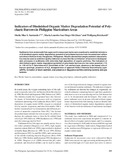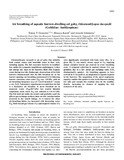Intertidal burrows of the air-breathing eel goby, Odontamblyopus lacepedii (Gobiidae: Amblyopinae)
- Global styles
- MLA
- Vancouver
- Elsevier - Harvard
- APA
- Help

View/
Date
2008Page views
1,056ASFA keyword
AGROVOC keyword
Taxonomic term
Metadata
Perlihat publikasi penuh
Share
Abstract
Odontamblyopus lacepedii inhabits burrows in mudflats and breathes air at the surface opening. Investigations of the intertidal burrows using resin casting demonstrated a highly branched burrow system. The burrows are composed primarily of branching patterns of interconnected tunnels and shafts that communicate into two to seven surface openings. Bulbous chambers (i.e., dilated portions of the burrow) at branching sections of the tunnels or shafts are common features of the burrow. The presence of these chambers accords the fish adequate space to maneuver inside the burrow, and thus constant access to the surface. The combination of all burrow characteristics and previously reported variability in air breathing patterns are ostensibly of selective value for aerial predator avoidance during air breathing in O. lacepedii.
Suggested Citation
Gonzales, T. T., Masaya, K., & Ishimatsu, A. (2008). Intertidal burrows of the air-breathing eel goby, Odontamblyopus lacepedii (Gobiidae: Amblyopinae). Ichthyological Research , 55(3), 303-306. https://doi.org/10.1007/s10228-008-0042-5
Type
ArticleISSN
1341-8998; 1616-3915Koleksi
- Journal Articles [1258]
Related items
Showing items related by title, author, creator and subject.
-
Indicators of diminished organic matter degradation potential of polychaete burrows in Philippine mariculture areas
Santander, Sheila Mae S.; San Diego-McGlone, Maria Lourdes; Reichardt, Wolfgang (University of the Philippines Los Baños, 2008)Sediments from underneath fish cages and in mesocosm tanks were examined to establish indicators of diminished organic matter degradation potential of polychaete burrows from increased mariculture activities in Bolinao-Anda, ... -
Gill structure, anatomy and habitat of Anodontia edentula: Evidence of endosymbiosis
Surveys and interviews were conducted to determine sources and habitat of Anodontia edentula. Results showed that they inhabit muddy substrate of mangrove areas or the adjacent mudflats, burying at 20-60 cm deep in the ... -
Air breathing of aquatic burrow-dwelling eel goby, Odontamblyopus lacepedii (Gobiidae: Amblyopinae)
Gonzales, Tomas T.; Katoh, Masaya; Ishimatsu, Atsushi (Company of Biologists, 2006)Odontamblyopus lacepedii is an eel goby that inhabits both coastal waters and intertidal zones in East Asia, including Japan. The fish excavates burrows in mudflats but, unlike the sympatric amphibious mudskippers, it does ...






